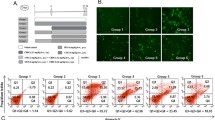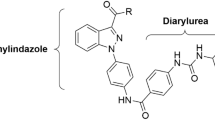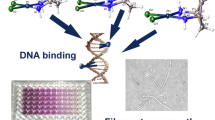Abstract
Many conventional anticancer drugs display relatively poor selectivity for neoplastic cells, in particular for solid tumors. Furthermore, expression or development of drug resistance, increased glutathione transferases as well as enhanced DNA repair decrease the efficacy of these drugs. Research efforts continue to overcome these problems by understanding these mechanisms and by developing more effective anticancer drugs. Cyclophosphamide is one of the most widely used alkylating anticancer agents. Because of its unique activation mechanism, numerous bioreversible prodrugs of phosphoramide mustard, the active species of cyclophosphamide, have been investigated in an attempt to improve the therapeutic index. Solid tumors are particularly resistant to radiation and chemotherapy. There has been considerable interest in designing drugs selective for hypoxic environments prevalent in solid tumors. Much of the work had been centered on nitroheterocyclics that utilize nitroreductase enzyme systems for their activation. In this article, recent developments of anticancer prodrug design are described with a particular emphasis on exploitation of selective metabolic processes for their activation.
Similar content being viewed by others
References Cited
Abele, R., Aapro, M. S., Haefliger, J-M. and Alberto, P., Phase I Study of Cyclophosphamide and Lysine Salt of Mafosfamide.Cancer Chemo. Pharmaco., 16, 182–183 (1986).
Aiko, I., Owari, S. and Torigoe, M., Nitrogen mustard N-oxide and its effects on the Yoshida sarcoma.J. Pharm. Soc. (Japan), 72, 1297–1300 (1952).
Alberts, D. S., Einspahr, J. G., Struck, R. F., Bignami, G., Young, L., Surwit, E. A. and Salmon, S. E., Comparative in vitro cytotoxicity of cyclophosphamide, its major active metabolites and the new oxazaphosphorine ASTA Z 7557 (INN mafosfamide).Inv. New Drugs, 2, 141–148 (1984).
Anders, M. W., Ratnayake, J. H., Hanna, P. E. and Fuchs, J. A., Involvement of thioredoxin in sulfoxide reduction by mammalian tissues.Biochem. & Biophys. Res. Comm., 97 (3), 846–851 (1980).
Aymard, C., Seyer, L. and Cheftel, J., Enzymatic reduction of methionine sulfoxide. In vitro experiments with rat liver and kidney.Agric. Biol. Chem., 43, 1869–1872 (1979).
Borch, R. F. and Canute, G. W., Synthesis and Antitumor Properties of Activated Cyclophosphamide Analogues.J. Med. Chem., 34, 3044–3052 (1991).
Borch, R. F. and Valente R. R., Synthesis, activation and cytotoxicity of aldophosphamide analogues.J. Med. Chem., 34, 3052–3058 (1991).
Boyd, V. L., Zon, G., Himes, V. L., Stalick, J. K., Mighell, A. D. and Secor, H. V., Synthesis and Antitumor Activity of Cyclophosphamide Analogues. 3. Preparation, Molecular Structure Determination, and Anticancer Screening of Racemic cis-and trans-4-Phenylcyclophosphamide.J. Med. Chem., 23, 372–375 (1980).
Brock, N., Comparative pharmacologic study in vitro and in vivo with cyclophosphamide (NSC-26271), cyclophosphamide metabolites, and plain nitrogen mustard compounds.Cancer Treat. Rep., 60, 301–307 (1976).
Brock, N. and Hohorst, H. J., The problem of specificity and selectivity of alkylating cytostaticis: Studies on N-2-chloroethylamido-oxazaphosphorines.Zeitschr. Krebsforsch. Klin. Onkol., 88, 185–215 (1977).
Brown, J. M., Tumor hypoxia: problems and opportunities. InEncyclopedia of Cancer, Volume III; Bertino, J. R. Ed.; Academic Press: San Diego, Lonton; pp 1883–1898, 1997.
Bruntsch, U., Groos, G., Hiller, T. A., Wandt, H., Tigges, F.-J. and Gallmeier, W. M., Phase-I Study of Mafosfamide-Cyclohexylamine (ASTA-Z-7557, NSC 345842) and Limited Phase-I Data on Mafosfamide-Lysine.Invest. New Drugs, 3, 293–296 (1985).
Colvin, M. and Hilton, J., In Mechanisms of Drug Resistance in Neoplastic Cells; Wooley, P. V.; Tew, K. D., Eds.: Academic Press: New York; p 161–171, 1988.
Connors, T. A. and Whisson, M. E., Cure of mice bearing advanced plasma cell tumors with aniline mustard: The relationship between glucurinidase activity and tumor sensitivity.Nature, 210, 866–867 (1966).
Connors, T. A., Farmer, P. B., Foster, A.B., Gilsenan, A. M., Jarman, M. and Tisdale, M. J., Metabolism of aniline mustard.Biochem. Pharmacol., 22, 1971–1980 (1973).
Connors, T. A., Cox, P. J., Farmer, P. B., Foster, A. B. and Jarman, M., Some studies of the active intermediates formed in the microsomal metabolism of cyclophosphamide and isophosphamide.Biochem. Pharmacol., 23, 115–129 (1974).
Connors, T. A., In “Structure-activity Relationships of Antitumour Agents”; Reinhoudt, D. N.; Connors, T. A.; Pinedo, H. M.; van den Poll, K. W., Eds.; The Hague: Martinus Nijhoff.; pp 47–57 (1983).
Cowan, D. S. M., Kanagasabapathy, V. M., McClelland, R. A. and Rauth, A. M., Mechanistic studies of enhanced in vitro radiosensitization and hypoxic cell cytotoxicity by targeting radiosensitizers to DNA via intercalation.Int. J. Radiation Oncology Biol Phys., 22, 541–544 (1992).
Cox, P. J., Cyclophosphamide cystitis-identification of acrolein as the causative agent.Biochem. Pharmacol., 28, 2045–2049 (1979).
Davis, P. J. and Guenthner, L. E., Sulindac oxidation/reduction by microbial cultures; microbial models for mammalian metabolism.Xenobiotica, 15, 845–857 (1985).
Denny, W. A. and Wilson, W. R., Considerations for the design of nitrophenyl mustards as agents with selective toxicity for hypoxic tumor cells.J. Med. Chem., 29 (6), 879–887 (1986).
Denny, W. A., Atwell, G. J., Anderson, R. F. and Wilson, W. R., Hypoxia-selective antitumor agents: 4. Relationships between structure, physicochemical properties, and hypoxia-selective cytotoxicity for nitracrine analogues with varying side chains: The “Iminoacridan Hypothesis”.J. Med. Chem., 33, 1288–1295 (1990).
Denny, W. A., Roberts, P. B., Anderson, R. F., Brown, J. M. and Wilson, W. R., NLA-1: A 2-nitroimidazole radiosensitizer targeted to DNA by intercalation.Int. J. Radiation Oncology Biol. Phys., 22, 553–556 (1992).
Domeyer, B. E. and Sladek, N. E., Kinetics of cyclophosphamide biotransformationin vivo.Cancer Res., 40, 174–180 (1980).
Draeger, U., Peter, G. and Hohorst, H. J., Deactivation of cyclophosphamide (NSC-26271) metabolites by sulfhydryl compounds.Cancer Treat. Rep., 60, 355–359 (1976).
Duggan, D. E., Hooke, K. F., Noll, R. M., Hucker, H. B. and Van Arman, C. G., Comparative disposition of sulindac and metabolites in five species.Biochem. Pharmacol., 27, 2311–2320 (1978).
Engel, T. W., Zon, G. and Egan, W.,31P NMR kinetic studies of the intra- and intermolecular alkylation chemistry of phosphoramide mustard and cognateN-phosphorylated derivatives ofN,N-bis(2-chloroethyl) amine.J. Med. Chem., 25, 1347–1357 (1982).
Fielden, E. M., Adams, G. E., Cole, S., Naylor, M. A., O'Neill, P., Stephens, M. A. and Stratford, I. J., Assessment of a range of novel nitro-aromatic radiosensitizers and bioreductive drugs.Int. J. Radiation Oncology Biol. Phys., 22, 707–711 (1992).
Firestone, A., Mulcahy, R. T. and Borch, R. F., Nitroheterocycle reduction as a paradigm for intramolecular catalysis of drug delivery to hypoxic cells.J. Med. Chem., 34, 2933–2935 (1991).
Friedman, O. M., Wodinsky, I. and Myles, A., Cyclophosphamide (NSC-26271)-related phosphoramide mustardsrecent advances and historical perspective.Cancer Treat. Rep., 60, 337–346 (1976).
Gomori, G., Histochemical demonstration of sites of phosphoramidase activity.Proc Soc Exp Biol Med, 69, 407–409 (1948).
Hemminki, K., Binding of metabolites of cyclophosphamide to DNA in a rat liver microsomal system and in vivo in mice.Cancer Res., 45, 4237–4243 (1985).
Hilton, J., Role of aldehyde dehydrogenase in cyclophosphamide-resistant L1210 leukemia.Cancer Res., 44, 5156–5160 (1984).
Hipkens, J. H., Struck, R. F. and Gurtoo, H. L., Role of aldehyde dehydrogenase in the metabolism-dependent biological activity of cyclophosphamide.Cancer Res., 41, 3571–3583 (1981).
Jardine, I., Fenselau, C., Appler, M., Kan, M.-N., Brundrett, R. B. and Colvin, M., Quantitation by gas chromatography-chemical ionization mass spectrometry of cyclophosphamide, phosphoramide mustard, and nornitrogen mustard in the plasma and urine of patients receiving cyclophosphamide therapy.Cancer Res., 38, 408–415 (1978).
Kennedy, K. A., Teicher, B. A., Rockwell, S. and Sartorelli, A. C., The hypoxic tumor cell: A target for selective cancer chemotherapy.Biochem. Pharmacol., 29, 1–8 (1980).
Kitamura, S. and Tatsumi, K., A sulfoxide-reducing enzyme system consisting of aldehyde oxidase and xanthine oxidase — a new electron transfer system.Chem. Pharm. Bull. (Japan), 31(2), 760–763 (1983).
won, C.-H., Borch, R. F., Engel, J. and Niemeyer, U., Activation Mechanisms of Mafosfamide and the Role of Thiols in Cyclophosphamide Metabolism.J. Med. Chem., 30, 395–399 (1987).
Kwon, C.-H., Moon, K.-Y., Baturay, N. and Shirota, F. N., Chemically stable, lipophilic prodrugs of phosphoramide mustard as potential anticancer agents.J. Med. Chem., 34, 588–592 (1991).
Kwon, C.-H., Blanco, D. R. and Baturay, N., p-(Methylsulfinyl)phenyl nitrogen mustard as a novel bioreductive prodrug selective against hypoxic tumors.J. Med. Chem., 35, 2137–2139 (1992).
Kwon, C.-H. Manuscripts in preparation (1999a and 1999b).
Lartigau, E. and Guichard, M., The effect of tirapazamine (SR-4233) alone or combined with chemotherapeutic agents on xenografted human tumours.British Journal of Cancer, 73, 1480–1485 (1996).
Lee, S. C. and Renwick, A. G., Sulphoxide reduction by rat and rabbit tissues in vitro.Biochem. Pharmacol., 49, 1557–1565 (1995).
Low, J. E., Borch, R. F. and Sladek, N. E., Conversion of 4-hydroperoxycyclophosphamide and 4-hydroxycyclophosphamide to phosphoramide mustard and acrolein mediated by bifunctional catalysts.Cancer Res., 42, 830–837 (1982).
Ludeman, S. M., Boyd, V. L., Regan, J. B., Gallo, K. A., Zon, G. and Ishii, K., Synthesis and Antitumor Activity of Cyclophosphamide Analogues. 4. Preparation, Kinetics Studies, and Anticancer Screening of “Phenylketophosphamide” and Similar Compounds Related to the Cyclophosphamide Metabolite Aldophosphamide.J. Med. Chem., 29, 716–727 (1986).
Lyttle, M. H., Satyam, A., Hocker, M. D., Bauer, K. E., Caldwell, C. G., Hui, H. C., Morgan, A. S., Mergia, A. and Kauvar, L. M., Glutathione-S-transferase activates novel alkylating agents.J. Med. Chem., 37, 1501–1507 (1994).
Mazel, P., Katzen, J., Skolnick, P. and Shargel, L., Reduction of sulfoxide by hepatic enzymes.Fed. Proc. Fed. Am. Soc. Exp. Biol., 28, 546 (1969).
Michinton, A. I., Lemmon, M. J., Tracy, M., Pollart, D. J., Martinez, A. P., Tosto, L. M. and Brown, J. M., Secondgeneration 1,2,4-benzotriazine 1,4-di-N-oxide bioreductive anti-tumor agents: pharmacology and activity in vitro and in vivo.Int. J. Radiation Oncology Biol. Phys., 22, 701–705 (1992).
Moon, K.-Y., Shirota, F. N., Baturay, N. and Kwon, C.-H., Chemically Stable N-Methyl-4-(alkylthio) cyclophosphamide Derivatives as Prodrugs of 4-Hydroxycyclophosphamide.J. Med. Chem., 38, 848–851 (1995).
Moon, K.-Y. and Kwon, C.-H., N3-Methyl-Mafosfamide as a Chemically Stable, Alternative Prodrug of Mafosfamide.Bioorg Med. Chem. Letters, 8: 1673–1678, (1998).
Oostveen, E. A. and Speckamp, W. N., Mitomycin analogues, I. Indoloquinones as (potential) bisalkylating agents.Tetrahedron, 43, 255–262 (1987).
Palmer, B. D., Wilson, W. R. and Denny, W. A., Nitro analogues of chlorambucil as potential hypoxiaselective anti-tumor drugs.Anti-cancer Drug Design, 5, 337–349 (1990a).
Palmer, B. D., Wilson, W. R., Pullen S. M. and Denny, W. A., Hypoxia-selective antitumor agents. 3. Relationships between structure and cytotoxicity against cultured tumor cells for substituted N,N-Bis(2-chloroethyl) anilines.J. Med. Chem., 33, 112–121 (1990b).
Palmer, B. D., Wilson, W. R., Cliffe, S. and Denny, W. A., Hypoxia-slective antitumor agents. 5. Synthesis of watersoluble nitroaniline mustards with selective cytotoxicity for hypoxic mammalian cells.J. Med. Chem., 35, 3214–3222 (1992).
Pohl, J., Asta-Z-7557, Summary for Investigators. Preclinical Report, Asta-Werke, 1983.
Pohl, J., Hilgard, P., Jahn, W. and Zechel, H. J., Experimental Toxicology of ASTAZ 7557 (INN mafosfamide).Invest. New Drugs, 2, 201–206 (1984).
Poste, G., Pathogenesis of metastatic disease. Implications for current therapy and for the development of new therapeutic strategies.Cancer Treat. Rep., 70, 183–199 (1986).
Powers, J. F. and Sladek, N. E., Cytotoxic activity relative to 4-hydroxycyclophosphamide and phosphoramide mustard concentrations in the plasma of cyclophosphamide-treated rats.Cancer Res., 43, 1101–1106 (1983).
Renwick, A. G., Sulfoxides and sulfones. In Sulfurcontainingdrugs and related organic compounds vol. 1 Part B; Damani, L. A., Ed. Ellis Horwood Ltd., London, 134–154 1989.
Sartorelli, A. C., Therapeutic attack of hypoxic ells of solid tumors: Presidential Address.Cancer Res., 48, 775–778 (1988).
Shibata, T., Shibamoto, Y., Sasai, K., Oya, N., Murata, R., Takagi, T., Hiraoka, M. and Abe, M., Comparison of in vivo efficacy of hypoxic cytotoxin tirapazamine and hypoxic cell radiosensitizer KU-2285 in combination with single and fractinated irradiation.Jpn. J. Cancer Res., 87, 98–104 (1996).
Sladek, N. E. and Landkamer, G. J., Restoration of sensitivity to oxazaphosphorines by inhibitors of aldehyde dehydrogenase activity in cultured oxazaphosphorineresistant L1210 and cross-linking agent-resistant P388 cell lines.Cancer Res., 45, 1549–1555 (1985).
Sladek, N. E., Low, J. E. and Landkamer, G. J., Collateral sensitivity to cross-linking agents exhibited by cultured L1210 cells resistant to oxazaphosphorines.Cancer Res., 45, 625–629 (1985).
Sladek, N. E., Metabolism of oxazaphosphorines.Pharmacol. Ther., 37, 301–355 (1988).
Sladek, N. E., Manthey, C. L., Maki, P. A., Zhang, Z. and Landkamer, G. J., Xenobiotic oxidation catalyzed by aldehyde dehydrogenases.Drug Metab. Rev., 20 (2–4), 697–720 (1989).
Sladek, N. E., Oxazaphosphorine-specific acquired cellular resistance. In: Teicher B.A., ed.Drug Resistance in Oncology. New York: Marcel Dekker., pp. 375–410, 1993.
Smigiero, L. and Kohn, K. W., Mechanisms of DNA strand breakage and interstrand cross-linking by diaziridinylbenzoquinone (diaziquone) in isolated nuclei.Cancer Res., 44, 4453–4457 (1984).
Sourkes, T. L. and Tano, Y., Reduction of methionine sulfoxides by Escherichia coli.Arch. Biochem. Biophys., 42, 321–326 (1953).
Stec, W. J., Cyclophosphamide and Its Congeners.J. Organophosphorous Chem., 13, 145–174 (1982).
Stratford, I. J., O'Neill, P., Sheldon, P. W., Silver, A. R. J., Walling, J. M. and Adams, G. E. RSU 1069. A nitroimidazole containing an aziridine group.Biochem. Pharm., 35(1), 105–109 (1986).
Struck, R. F., Kirk, M. C., Witt, M. H. and Laster, W. R. Jr., Isolation and mass spectral identification of blood metabolites of cyclophosphamide: Evidence for phosphoramide mustard as the biologically active metabolite.Biomed. Mass Spectrom., 2, 46–52 (1975).
Struck, R. F., Dykes, D. J., Corbett, T. H., Suling, W. J. and Trader, M. W., Isophosphoramide mustard, a metabolite of ifosfamide with activity against murine tumours comparable to cyclophosphamide.Br. J. Cancer, 47, 15–26 (1983).
Suto, MJ, Radiosensitizers.Ann. Rep. Med. Chem. 26: 151–160 (1991).
Tatsumi, K., Kitamura, S. and Yamada, H., Involvement of liver aldehyde oxidase in sulfoxide reduction.Chem. Pharm. Bull. (Japan), 30(12), 4585–4588 (1982).
Tew, K. D. and Clapper, M. L., Glutathione-S-transferase and anticancer drug resistance.In Mechanism of Drug resistance in Neoplastic Cells; Wooley, P.V., Tew, K.D., Eds.; Academic Press: Orlando, FL; pp 141–159, 1987.
Tomasz, M., Lipman, R., Chowdary, D., Pawlak, J., Verdine, G. L. and Nakanish, K., Isolation and structure of a covalent cross-link adduct between mitomycin C and DNA.Science, 235, 1204–1208 (1987).
Vu, V. T., Fenselau, C. C. and Colvin, M. Identification of three alkylated nucleotide adducts from the reaction of guanosine 5′-monophosphate with phosphoramide mustard.J. Am. Chem. Soc., 103, 7362–7364 (1981).
Walton, M. I., Wolf, C. R. and Workman, P., Molecular enzymology of the bioactivation of hypoxic cell cytotoxins.Int. J. Radiat. Oncol. Biol. Phys., 16, 983–986 (1989).
Walton, M. I. and Workman, P., Enzymology of the reductive bioactivation of SR 4233. A novel benzotriazine di-N-oxide hypoxic cell cytotoxin.Biochem. Pharmacol., 39, 1735–1742 (1990).
Wang, Y. and Farquhar, D., Aldophosphamide acetal diacetate and structural analogues: synthesis and cytotoxicity studies.J. Med. Chem., 34, 197–203 (1991).
Warren, B. A., In Tumor Blood Circulation. Angiogenesis, vascular morphology and blood flow in experimental and humantumors. Peterson, H.-I., Ed. CRC Press: Boca Raton, FI, 1–47, 1978.
White, I. N. H., Suzanger, M., Mattocks, A. R., Bailey, E., Farmer, P. B. and Conners, T. A., Reduction of nitromin to nitrogen mustard: unsceduled DNA synthesis in aerobic or anaerobic rat hepatocytes, JB1, BL8 and Walker carcinoma cell lines.Carcinogenesis, 10, 2113 (1989).
Wilson, W. R., Anderson, R. F. and Denny, W. A., Hypoxia-selective antitumor agents. 1. Relationships between structure, redox properties and hypoxia-selective cytotoxicity for 4-substituted derivatives of nitracrine.J. Med. Chem., 32, 23–30 (1989a).
Wilson, W. R., Thompson, L. H., Anderson, R. F. and Denny, W. A., Hypoxia-selective antitumor agents. 2. Electronic effects of 4-substituents on the mechanisms of cytotoxicty and metabolic stability of nitracrine derivatives.J. Med. Chem., 32, 31–38 (1989b).
Workman, P. and Walton, M. I., Enzyme-directed bioreductive drug development In “Selective activation of drugs by redox process”, Adams, G. E.; Breccia, A.; Fielden, E. M.; Wardman, P. eds., New York, NY, Plenum; pp. 173–191, 1991.
Workman, P., Bioreductive mechanisms.Int. J. Radiat. Oncol. Biol. Phys., 22, 631–637 (1992).
Wrabetz, E., Peter, G. and Hohorst, H.-J., Does acrolein contribute to the cytotoxicity of cyclophosphamide?Cancer Res. Clin. Oncol., 98, 119–126 (1980).
Young, C. W., Yogoda, A., Bitlar, E. S., Smith, S. W., Gradstald, H. and Whitmore, W., Therapeutic trial of aniline mustard in patients with advanced cancer. Comparison of the therapeutic response with cytochemical assessment of tumor cell β-glucuronidase activity.Cancer, 38, 1887–1895 (1976).
Yoshihara, S. and Tatusumi, K., Guinea pig liver aldehyde oxidase as a sulfoxide reductase: its purification and characterization.Arch. Biochim. Biophys., 242, 213–224 (1985).
Zon, G., Cyclophosphamide Analogues.Prog. Med. Chem., 19, 205–246 (1982).
Author information
Authors and Affiliations
Corresponding author
Rights and permissions
About this article
Cite this article
Kwon, CH. Metabolism-based anticancer drug design. Arch Pharm Res 22, 533–541 (1999). https://doi.org/10.1007/BF02975322
Received:
Issue Date:
DOI: https://doi.org/10.1007/BF02975322




